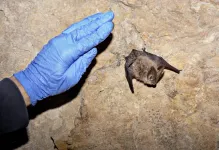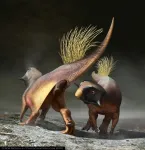INFORMATION:
The study was funded by an award from the Strategic Environmental Research and Development Program(SERDP;) - the Department of Defense's environmental science and technology program that is executed in partnership with the Department of Energy and the Environmental Protection Agency. The research involved a consortium of partners including Texas Tech University, Montana State University, Massey University in New Zealand, Wildlife Conservation Society Canada, Conservation Science Partners and the Wildlife Conservation Society.
About the WCS (Wildlife Conservation Society)
The Wildlife Conservation Society (WCS) is a US non-profit, tax-exempt, private organization established in 1895 that saves wildlife and wild places by understanding critical issues, crafting science-based solutions, and taking conservation actions that benefit nature and humanity. With more than a century of experience, long-term commitments in dozens of landscapes, presence in more than 60 nations, and experience helping to establish over 150 protected areas across the globe, WCS has amassed the biological knowledge, cultural understanding and partnerships to ensure that vibrant, wild places and wildlife thrive alongside local communities. Working with local communities and organizations, that knowledge is applied to address species, habitat and ecosystem management issues critical to improving the quality of life of poor rural people whose livelihoods depend on the direct utilization of natural resources. WCS was the first conservation organization with a dedicated team of wildlife veterinarians and other health professionals deployed around the world. The WCS Health Program is central to delivering on our mission to save wildlife and wild places around the globe. Wildlife, livestock, and human diseases will likely have a significant impact on the future development of sustainable land uses, protected areas, transboundary natural resource management, other biodiversity conservation approaches, and livelihood opportunities in many of the landscapes and seascapes where we work. Our work at the interface of wildlife, domestic animal, and human health has demonstrated that a One Health approach can build new constituencies for conservation and strengthen existing ones, while mitigating a key threat to conservation. Today, WCS Health Programs are globally recognized for excellence in zoological and wildlife medicine, pathology, and global health conservation initiatives. Visit: newsroom.wcs.org Follow: @WCSNewsroom. For more information: 347-840-1242.
About Austin Peay State University
Austin Peay State University (APSU; apsu.edu) is a moderately-sized state university located in middle Tennessee. APSU serves a large population of diverse students with several degree options at the associates, bachelor's, master's and doctoral levels. Many of these degrees can be pursued on campus and online. APSU is home to the state's only Center of Excellence for Field Biology, which enables students to work with professional field biologists in the study of mammals, insects, fish, plants and more.
About WCS Canada
Wildlife Conservation Society (WCS) Canada was incorporated as a conservation organization in Canada in 2004. The mission of WCS Canada is to conserve wildlife and wild places by understanding the issues, developing science-based solutions, and working with others to carry out conservation actions across Canada. WCS Canada is distinguished from other environmental organizations through their role in generating science through field and applied research, and by using results to encourage collaboration among scientific communities, organizations and policy makers to achieve conservation results.
About TTU
A new era of excellence is dawning at Texas Tech University as it stands on the cusp of being one of the nation's premier research institutions. Research and enrollment numbers are at record levels, which cement Texas Tech's commitment to attracting and retaining quality students. In fall 2020, the university achieved a goal more than a decade in the making, reaching a total student population of more than 40,000. In 2018, the Carnegie Classification of Institutions of Higher Education again placed Texas Tech among its top doctoral universities in the nation in the "Very High Research Activity" category. Texas Tech is one of 94 public institutions nationally and 131 overall to achieve this prestigious recognition. Quality students need top-notch faculty. Texas Tech is home to a diverse, highly revered pool of educators who excel in teaching, research and service. The university strives to foster an environment that celebrates student accomplishment above all else. Texas Tech is large enough to provide the best in facilities and academics but prides itself on being able to focus on each student individually.
The momentum for excellence at Texas Tech has never been greater.
About MSU
Montana State University is a public university located in Bozeman, Montana. It was founded in 1893 as the state's land-grant institution and prides itself on its tripartite mission of excellence in teaching and learning, research and creative projects and outreach and service. With an enrollment of more than 15,600 students, MSU is the largest university in the state. It is also the largest research university in Montana and the largest research and development entity of any kind in Montana, with annual research expenditures typically exceeding $100 million annually. Through its colleges, MSU offers baccalaureate degrees in more than 50 fields, master's degrees in more than 40 fields, and doctoral degrees in approximately 20 fields. To learn more, visit http://www.montana.edu/.
About Massey U
Massey University is New Zealand's largest and most influential educational institution with around 32,500 students. It calls itself New Zealand's defining university because its areas of specialized teaching and world-class research reflect what New Zealand and New Zealanders are best known for - agrifood innovation and the associated disciplines such as public health, animal welfare, farming and food technology, design, creative arts, social sciences, and business. It has five colleges (faculties), around 3000 full-time equivalent staff and the nation's largest university-based distance education program, allowing students to study from anywhere in the world.
About CSP
Conservation Science Partners (CSP; csp-inc.org) is a nonprofit scientific collective established to meet the analytical and research needs of diverse stakeholders in conservation outcomes on public and private lands. The mission of CSP is to apply human ingenuity to the preservation of species, populations, and ecosystems using scientific principles, innovative approaches, and lasting partnerships with conservation practitioners. CSP connects the best minds in conservation science to solve environmental problems in a comprehensive, flexible, and service-oriented manner. The core capabilities of CSP span a wide spectrum of geospatial and statistical techniques, from custom ecological and environmental data development (GIS and remote sensing based) to advanced analyses of landscape patterns and changes at multiple spatial and temporal scales.
Disease threatens to decimate western bats
White-nose syndrome predicted to drastically impact hibernating bat species in the West
2021-01-19
(Press-News.org) BOZEMAN, Montana (January 19, 2021) - A four-year study recently published in Ecology and Evolution concludes that the fungal disease, white-nose syndrome, poses a severe threat to many western North American bats.
Since it was first detected in 2006, white-nose syndrome has killed millions of bats in eastern and central North America. The spread of the fungal pathogen that causes white-nose syndrome in hibernating bats has reached several western U.S. states, mostly likely through bat-to-bat spread, and is presently threatening western species.
Bats with white-nose syndrome have fungus growing on their nose and wings, as the name implies, but the fungal infection also triggers a higher frequency of arousals from hibernation. Each arousal involves an increase in body temperature from as low as near freezing (when bats use torpor) to an active mammalian body temperature (~98?F or 38?C), which uses a significant amount of energy. Bats have limited fat stored for the winter, and if this is used up before the end of winter, death by starvation occurs.
The researchers' aim was to provide managers with information on which western bat species may suffer high mortality and extinction risk if infected with the disease. To do so they combined an unprecedented field data collection effort with a mechanistic model that explains how energy is consumed during hibernation and how the causal fungus impacts this energy consumption. By comparing their new knowledge of how long bats infected with white-nose syndrome could hibernate against the duration of winter that they would need to hibernate with the disease, the authors predicted survival outcomes for each species. If a bat did not have sufficient energy to live beyond the duration of winter the simulation recorded a mortality.
Three years of intensive fieldwork resulted in 946 bat captures (all released after measuring). Bat energetic measurements paired with hibernaculum environmental data were gathered for nine species that were sampled at eight sites scattered throughout the West (see Figure A). The researchers then assessed how the arrival of white-nose syndrome might affect hibernation energy use, and subsequently each species' ability to survive hibernation with the disease. Combining data on the host, the environment they select for hibernation, and how the pathogen grows at different temperature and humidity conditions the authors simulated how many days infected populations could hibernate under field conditions.
The study revealed there are white-nose syndrome threats to all the small Myotis species examined, including M. ciliolabrum (western small-footed bat), M. evotis (long-eared bat), M. lucifugus (little brown bat), M. thysanodes (fringed myotis), and M. volans (long-legged bat), as well as Perimyotis subflavus (tricolored bat). In comparison, larger species like M. velifer (cave bat), Corynorhinus townsendii (Townsend's big-eared bat) and Eptesicus fuscus (big brown bat) are predicted to be less impacted. Further analysis showed body mass (and relatedly body-fat as these attributes are correlated) as well as hibernaculum water vapor deficit (i.e. relative humidity) explained over half the variation observed in bat survival.
Dr. Catherine Haase, now Assistant Professor of Biology at Austin Peay State University and the study's lead author said: "Our results indicate the need to take a holistic view on conservation, as it is not just one thing that determines survival from white-nose syndrome, but rather the combination of bat, environment, and disease variables."
All of the western bat species studied were insectivores, meaning they prey on insects, including those that are pests to agricultural crops. In addition to providing valuable ecosystem services, they are incredibly fascinating species, from their ability to echolocate to their unique immune system.
Dr. Sarah Olson, Wildlife Conservation Society Health Program co-author and project Principle Investigator said: "This study demonstrates the value of collecting baseline data to pre-emptively understand a threat posed by a wildlife disease, like white-nose syndrome, to western bats, so that more proactive conservation measures can be taken to protect these species. Here, an all hands on deck approach is needed. Western states can take steps now to put protections in place before anticipated severe declines are observed, like reducing habitat loss and restricting access to hibernacula, as well as investing in research and surveillance."
ELSE PRESS RELEASES FROM THIS DATE:
Where do our minds wander? Brain waves can point the way
2021-01-19
Anyone who has tried and failed to meditate knows that our minds are rarely still. But where do they roam? New research led by UC Berkeley has come up with a way to track the flow of our internal thought processes and signal whether our minds are focused, fixated or wandering.
Using an electroencephalogram (EEG) to measure brain activity while people performed mundane attention tasks, researchers identified brain signals that reveal when the mind is not focused on the task at hand or aimlessly wandering, especially after concentrating on an assignment.
Specifically, increased alpha brain waves were detected in the prefrontal cortex of ...
Counting elephants from space
2021-01-19
For the first time, scientists have successfully used satellite cameras coupled with deep learning to count animals in complex geographical landscapes, taking conservationists an important step forward in monitoring populations of endangered species.
For this research, the satellite Worldview 3 used high-resolution imagery to capture African elephants moving through forests and grasslands. The automated system detected animals with the same accuracy as humans are able to achieve.
The algorithm that enabled the detection process was created by Dr Olga Isupova, a computer scientist at the University of Bath in the UK. The project was a collaboration with the UK's University of Oxford and the University of Twente in the Netherlands.
Dr ...
5G doesn't cause COVID-19, but the rumor it does spread like a virus
2021-01-19
People's fear of 5G technology is rational. Such technology does emit radiation, even if it's at low levels. But 5G isn't all that different from 4G, and it certainly doesn't cause COVID-19 despite such rumors having spread rapidly across the globe.
Researchers need to better understand how misinformation like this spreads in order to hone their intervention efforts and prevent misinformed perspectives from taking root. In society's virtual world, preventing technological misinformation, in particular, is important now more than ever.
A research team led by Elaine Nsoesie, a Hariri Institute Faculty Fellow, investigated how COVID-19 misinformation proliferated using ...
Study in twins identifies fecal microbiome differences in food allergies
2021-01-19
A new study out of the University of Chicago and Stanford University on pairs of twins with and without food allergies has identified potential microbial players in this condition. The results were published on Jan. 19 in the Journal of Clinical Investigation.
The study grew out of prior research in the Nagler laboratory at UChicago on the fecal microbiota in infants. By transplanting fecal microbes from healthy and food-allergic infants to germ-free mice (who do not possess a microbiome), investigators found that the healthy infant microbiota was protective against the development ...
New clues help explain why PFAS chemicals resist remediation
2021-01-19
The synthetic chemicals known as PFAS, short for perfluoroalkyl and polyfluoroalkyl substances, are found in soil and groundwater where they have accumulated, posing risks to human health ranging from respiratory problems to cancer.
New research from the University of Houston and Oregon State University published in Environmental Science and Technology Letters suggests why these "forever chemicals" - so called because they can persist in the environment for decades - are so difficult to permanently remove and offers new avenues for better remediation practices.
The work focused on the interactions sparked when firefighters use ...
Fatty acid may help combat multiple sclerosis
2021-01-19
The abnormal immune system response that causes multiple sclerosis (MS) by attacking and damaging the central nervous system can be triggered by the lack of a specific fatty acid in fat tissue, according to a new Yale study. The finding suggests that dietary change might help treat some people with the autoimmune disease.
The study was published Jan. 19 in The Journal of Clinical Investigation.
Fat tissue in patients diagnosed with MS lack normal levels of oleic acid, a monounsaturated fatty acid found at high levels in, for instance, cooking oils, meats (beef, chicken, and pork), cheese, nuts, sunflower seeds, eggs, pasta, ...
Researchers discover mechanism behind most severe cases of a common blood disorder
2021-01-19
With a name like glucose-6-phosphate dehydrogenase deficiency, one would think it is a rare and obscure medical condition, but that's far from the truth. Roughly 400 million people worldwide live with potential of blood disorders due to the enzyme deficiency. While some people are asymptomatic, others suffer from jaundice, ruptured red blood cells and, in the worst cases, kidney failure.
Now, a team led by researchers at the Department of Energy's SLAC National Accelerator Laboratory have uncovered the elusive mechanism behind the most severe cases of the ...
Eggs reveal what may happen to brain on impact
2021-01-19
WASHINGTON, January 19, 2021 -- What causes brain concussions? Is it direct translational or rotational impact? This is one of the research areas currently being explored by Qianhong Wu's lab at Villanova University.
Our brains consist of soft matter bathed in watery cerebrospinal fluid (CSF) inside a hard skull. An impact on the hard skull is transmitted through the thin layer of CSF within the subarachnoid space to the soft brain matter.
In Physics of Fluids, from AIP Publishing, Wu and co-authors Ji Lang and Rungun Nathan describe studying another system with the same features, an egg, to search for answers. An egg resembles the brain, because its soft yolk is bathed within a liquid egg white inside a hard shell.
Considering that in most concussive brain injuries, the skull does ...
All-purpose dinosaur opening reconstructed for first time
2021-01-19
For the first time ever, a team of scientists, led by the University of Bristol, have described in detail a dinosaur's cloacal or vent - the all-purpose opening used for defecation, urination and breeding.
Although most mammals may have different openings for these functions, most vertebrate animals possess a cloaca.
Although we know now much about dinosaurs and their appearance as feathered, scaly and horned creatures and even which colours they sported, we have not known anything about how the vent appears.
Dr Jakob Vinther from the University of Bristol's School of Earth Sciences, along with colleagues Robert Nicholls, a palaeoartist, and Dr Diane Kelly, ...
Obese, snoring mini pigs show how air flows through the throat during sleep apnea
2021-01-19
With a small snout, a short and curled tail, and a big, round stomach, mini pigs are the epitome of cute--and sometimes, they snore. Now, researchers think these snoring pigs can be used to study obstructive sleep apnea. A study appearing January 19 in the journal Heliyon found that obese Yucatan mini pigs do have naturally occurring sleep apnea and that MRI scans taken while they're in sedated sleep can be used to gain new insights into what happens in the airways during sleep apnea episodes via computational flow dynamic (CFD) analysis.
"These are very fat pigs," says first author Zi-Jun Liu, a research professor and principal investigator in the Department of Orthodontics ...
LAST 30 PRESS RELEASES:
Researchers identify gene that calms the mind and improves attention in mice
Artificial metabolism turns waste CO2 into useful chemicals
Ancient sea anemone sheds light on animal cell type evolution
Begging gene leads to drone food
How climate policies that incentivize and penalize can drive the clean energy transition
Can community awareness campaigns in low-resource areas improve early diagnosis of colorectal cancer?
Stardust study resets how life’s atoms spread through space
Practical education: Clinical scenario-based program development
The impact of family dynamics on eating behaviour – how going home for Christmas can change how you eat
Tracing the quick synthesis of an industrially important catalyst
New software sheds light on cancer’s hidden genetic networks
UT Health San Antonio awarded $3 million in CPRIT grants to bolster cancer research and prevention efforts in South Texas
Third symposium spotlights global challenge of new contaminants in China’s fight against pollution
From straw to soil harmony: International team reveals how biochar supercharges carbon-smart farming
Myeloma: How AI is redrawing the map of cancer care
Manhattan E. Charurat, Ph.D., MHS invested as the Homer and Martha Gudelsky Distinguished Professor in Medicine at the University of Maryland School of Medicine
Insilico Medicine’s Pharma.AI Q4 Winter Launch Recap: Revolutionizing drug discovery with cutting-edge AI innovations, accelerating the path to pharmaceutical superintelligence
Nanoplastics have diet-dependent impacts on digestive system health
Brain neuron death occurs throughout life and increases with age, a natural human protein drug may halt neuron death in Alzheimer’s disease
SPIE and CLP announce the recipients of the 2025 Advanced Photonics Young Innovator Award
Lessons from the Caldor Fire’s Christmas Valley ‘Miracle’
Ant societies rose by trading individual protection for collective power
Research reveals how ancient viral DNA shapes early embryonic development
A molecular gatekeeper that controls protein synthesis
New ‘cloaking device’ concept to shield sensitive tech from magnetic fields
Researchers show impact of mountain building and climate change on alpine biodiversity
Study models the transition from Neanderthals to modern humans in Europe
University of Phoenix College of Doctoral Studies releases white paper on AI-driven skilling to reduce burnout and restore worker autonomy
AIs fail at the game of visual “telephone”
The levers for a sustainable food system
[Press-News.org] Disease threatens to decimate western batsWhite-nose syndrome predicted to drastically impact hibernating bat species in the West



